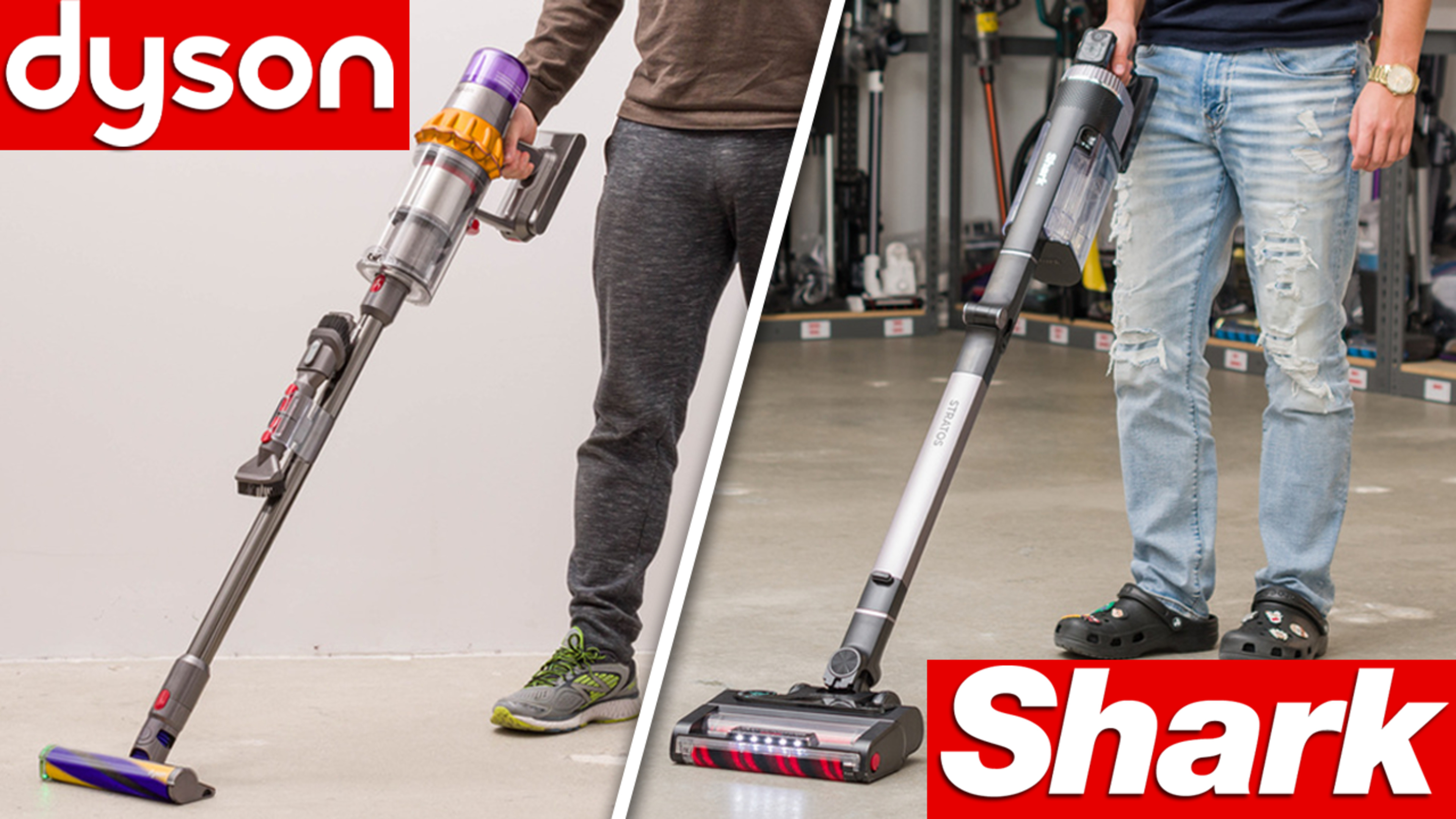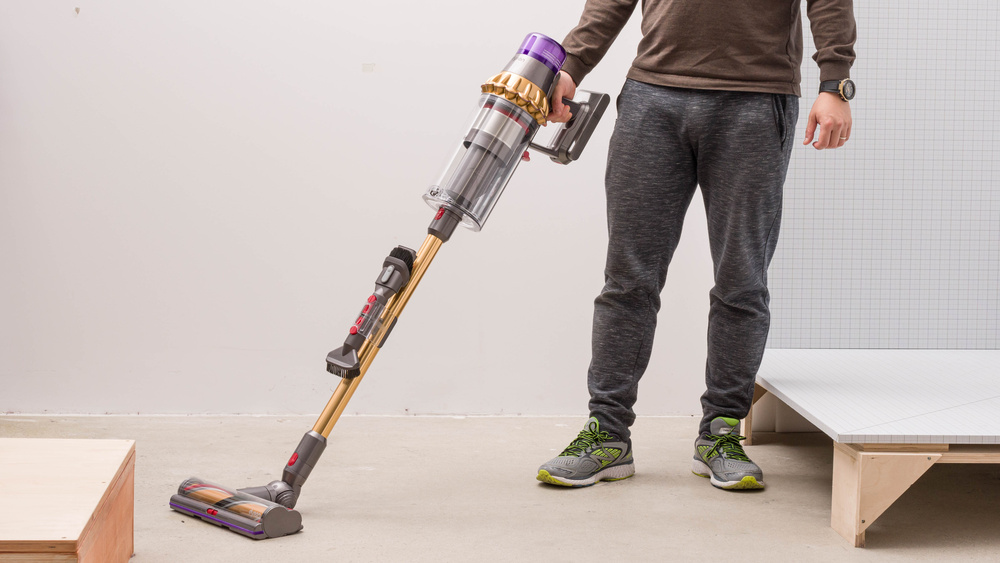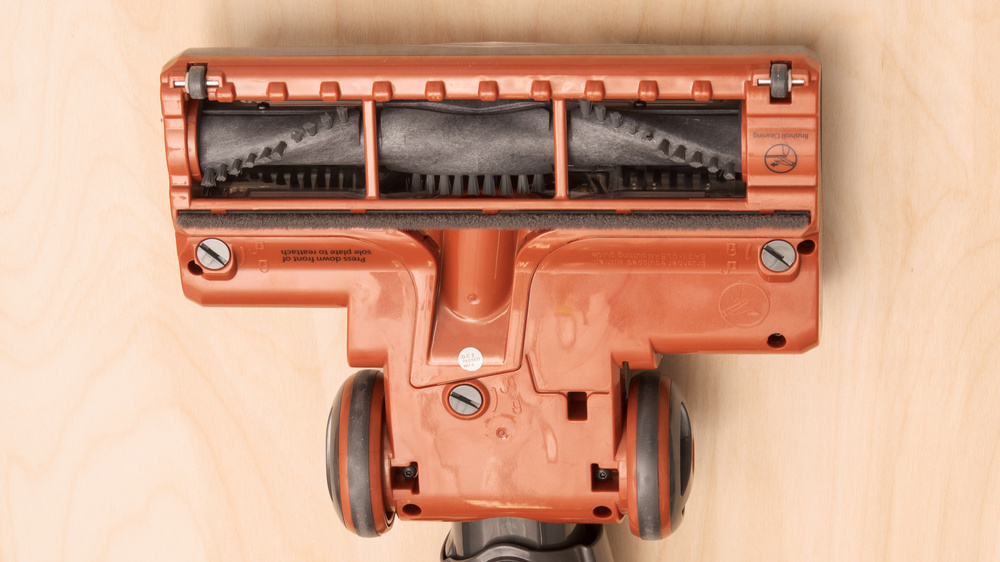
Dyson and Shark are two titans of the modern household vacuum industry, each enjoying a level of brand recognition that isn't common within the industry.
Dyson is a pioneer in bagless technology, with founder James Dyson having designed and engineered the world's first cyclonic vacuuming system intended for household use. The Kleeneze Rotork Cyclon was released in 1983 for the UK market and was the first vacuum to use his design. While the company can't claim to be the have also been the first to sell a cordless vacuum, they're no doubt responsible for the current ubiquity of stick models, a rise in popularity driven in part by the marriage of portability, ease of use, and almost Apple-like design flair.
Shark, one half of the massive home appliance conglomerate SharkNinja, can't claim to have the same design cachet; however, it does offer an enormous range of vacuum types that cater to a wide variety of budgets and user requirements, with most of their models occupying a far more affordable price point than Dyson's offerings. They've also made their contributions to vacuum technology, with multiple iterations of anti-tangle floorhead designs and highly-reconfigurable upright vacuum platforms.
Test results
Dyson vs Shark: Cordless Vacuums
Given the company's extensive expertise in building cordless stick vacuums, it's no surprise that Dyson's offerings in this area are extensively refined and provide a great user experience. The Dyson V15 Detect represents the apex of the brand's offerings, pairing a massively potent 230 AW suction motor with a fairly lightweight body weighing in at just under six and a half pounds. It also carries over the older Dyson V11's automatic power adjustment feature, which allows the vacuum to ramp up suction power on carpeted floors but differs from the older model with the inclusion of a built-in piezo sensor that lets the vacuum automatically count and measure the size of debris being sucked into it. This info is then displayed through an LED screen at the back of the body. For some users, this could be considered a bit of a gimmick, but if you suffer from allergies and would like a rough idea of allergen quantities in your home, it's certainly worth a look.
Just under the V15 sits the newer yet less expensive Dyson V12 Detect Slim. Feature set-wise, the V12 and V15 are pretty similar; both vacuums have particle sensors and an automatic power adjustment system, though the V12 can also modulate its suction power depending on the amount of debris being sucked up. They also both come with secondary floorheads with laser lights to help you see fine material on hard floors. The biggest difference is physical; the V12 is a considerably smaller, lighter vacuum. This makes it easier to maneuver and carry around, but it has downsides: a less powerful suction motor and a tiny dustbin that'll need frequent emptying.
Both the V12 and V15 will run for up to an hour on a single charge, which is pretty good for a vacuum of this type. Better yet, their battery packs are removable and replaceable, so you can swap in a new pack if the current unit's performance has degraded over time.
 Dyson V15 Detect
Dyson V15 Detect Shark Stratos Cordless
Shark Stratos CordlessShark's current best example of the breed is the Shark Stratos Cordless. At over eight and a half pounds, it's a heavier machine than any other cordless model in Dyson's lineup, so it isn't quite as maneuverable or as portable as models like the V12 or V15. That said, as a flagship model in Shark's lineup, it's jam-packed with a variety of features. Like the Dyson V12, it can automatically adjust its suction power depending on the quantity of material being sucked up, boosting power for tasks that require a little more power and keeping it to a minimum when dealing with lightweight debris that won't require quite as much oomph. It won't adjust its suction power automatically based on floor type. It also features a unique odor-neutralization feature, which works through a replaceable cartridge in its floorhead that emanates a detergent-like scent as you clean. You can adjust the intensity of this scent by twisting the cartridge in its housing. Battery performance is similar to both Dysons, with max runtime at about an hour.
The Shark's bulkiness is somewhat offset by its hinged wand, which makes it significantly easier to clean under most tables and chairs since you won't have to bend too deeply. The bigger size does come with a few other advantages. Despite its cheaper price point, the Shark is built mainly from denser, thicker plastic and consequently feels sturdier. Its dustbin has a capacity of 0.65L, which is larger than any cordless Dyson currently on offer, other than the Dyson Outsize, which has a 1.52L dustbin, a colossal size for a stick vacuum.
 Dyson Outsize
Dyson Outsize Shark Vertex Pro Powered Lift-Away
Shark Vertex Pro Powered Lift-AwayOn that note, Shark also offers a cordless interpretation of a full-size vacuum, one that goes in a different direction than Dyson's plus-sized stick vacuum. The Shark Vertex Pro Powered Lift-Away is built along the lines of a more conventional upright vacuum, which makes sense from a user perspective. A larger dustbin will hold more debris, bringing more weight; moving this load closer to the ground makes it easier to maneuver when full compared to the Dyson, which places the weight of its massive dustbin in your hand, increasing hand and wrist fatigue during longer cleaning sessions. For raw suction power, the Dyson Outsize outpaces the Shark Vertex.
When comparing cheaper, older models from Dyson like the Dyson V7 or Dyson V8 to older Shark models like the Shark Rocket Pet Pro, the Shark Cordless Pet Plus, and the Shark Vertex Lightweight Cordless, general trends are still present. Dyson vacuums tend to be smaller, more maneuverable, a little more potent, and are available with a wider array of attachments, while Shark vacuums have a greater debris capacity and feel a little more solidly built.
Below is a rundown of some of the key design aspects of a few of the previously mentioned vacuums:
|
Vacuum |
Measured Max Suction At Floorhead | Dustbin Capacity | Min/Max Runtime (Single Battery) | Weight |
| Dyson V7 |
2.1 inH₂O (0.52 kPa) |
0.09 gal (0.35 L) |
7.5 - 33 min | 5.22 lbs (2.37 kg) |
| Dyson V8 |
3.3 inH₂O (0.83 kPa) |
0.09 gal (0.35 L) |
8 - 41 min | 5.58 lbs (2.53 kg) |
| Dyson V11 |
5.9 inH₂O (1.48 kPa) |
0.12 gal (0.45 L) | 8 - 76 min | 7.72 lbs (3.50 kg) |
| Dyson V12 Detect Slim |
6.1 inH₂O (1.51 kPa) |
0.04 gal (0.16 L) | 8.2 - 70 min | 5.20 lbs (2.36 kg) |
| Dyson V15 Detect |
9.8 inH₂O (2.44 kPa) |
0.12 gal (0.45 L) |
8 - 75 min | 6.46 lbs (2.93 kg) |
|
6.9 inH₂O (1.73 kPa) |
0.40 gal (1.52 L) |
9 - 76 min | 8.16 lbs (3.70 kg) | |
| Shark Rocket Pet Pro |
1.2 inH₂O (0.29 kPa) |
0.13 gal (0.50 L) |
12 - 42 min | 7.94 lbs (3.60 kg) |
| Shark Cordless Pet Plus |
0.8 inH₂O (0.20 kPa) |
0.20 gal (0.75 L) |
14 - 41 min | 7.63 lbs (3.46 kg) |
| Shark Vertex Lightweight Cordless |
2.2 inH₂O (0.56 kPa) |
0.18 gal (0.70 L) | 19 - 38 min | 9.15 lbs (4.15 kg) |
| Shark Vertex Pro Powered Lift-Away |
3.9 inH₂O (0.98 kPa) |
0.21 gal (0.80 L) | 10.1 - 63 min | 12.57 lbs (5.70 kg) |
| Shark Stratos Cordless |
3.9 inH₂O (0.96 kPa) |
0.17 gal (0.65 L) | 12 - 63 min | 8.73 lbs (3.96 kg) |
If you'd like to see a rundown of all the cordless models offered by Shark and Dyson, see the table linked here.
Dyson vs Shark: Corded Vacuums
Pickings for corded Dyson models are pretty slim. As it stands, Dyson still offers all three generations of the Dyson Ball bagless upright: the original Dyson Ball, the Dyson Ball Animal 2, and the newest Dyson Ball Animal 3. The latter is easily the pick of the litter, thanks to some choice upgrades that vastly improve the overall user experience. The most obvious change from the Ball Animal 2 to the Ball Animal 3 is the redesigned floorhead, which features three levels of height adjustment, making it considerably easier to maneuver on thickly carpeted floors, as well as a set of pronounced vanes that are highly effective in capturing long strands of hair. Unfortunately, build quality has remained consistently mediocre across successive generations, with a mainly plastic construction that creaks and flexes while in use; this is pretty disappointing for a vacuum at this price point.
 Dyson Ball Animal 3
Dyson Ball Animal 3 Shark Apex Upright
Shark Apex UprightUnlike Dyson, Shark has persisted in maintaining a pretty large selection of corded vacuums in several different configurations. If you're the kind of buyer who isn't fully onboard with the cordless revolution, you should probably look at what they offer first. Shark's best known for their selection of upright vacuums, which include the Navigator and Rotator ranges; we've tested the Shark Rotator Powered Lift-Away, the Shark Rotator Lift-Away ADV, the Shark Navigator Lift-Away Deluxe, and the Shark Navigator Lift-Away Speed. Most use the brand's 'Lift-Away' design, which places the main motor unit and dustbin within a removable canister module that can be lifted free of its floorhead and wand and carried around in one hand, enabling you to clean hard-to-reach areas with greater ease than the more traditionally-configured Dyson.
The best corded Shark vacuum we've tested is the Shark APEX Upright. It feels more sturdily built than the Dyson Ball Animal 3, as well as cheaper upright models in Shark's lineup. It also delivers stellar performance on bare floors and does a pretty good job on low and high-pile carpets. However, for raw suction power, it falls short of the Dyson. Its floorhead is more tangle-prone, and unlike the Dyson, it isn't height-adjustable, which would make it easier to clean shaggier carpeting.
If you find upright vacuums a tad too big and bulky for your needs, Shark also offers an array of corded stick models. The flagship model in that lineup is the Shark Stratos UltraLight, which shares a name and a few features with its cordless stablemate. While it can't automatically modulate its suction power and lacks a folding wand, it uses the same PowerFins HairPro floorhead and odor-neutralizing system, making it an excellent option for pet owners.
|
Vacuum |
Measured Max Suction At Floorhead | Dustbin Capacity | Range | Weight |
| Dyson Ball Animal 2 |
2.9 inH₂O (0.72 kPa) |
0.32 gal (1.20 L) | 37.89 ft (11.55 m) | 17.20 lbs (7.80 kg) |
| Dyson Ball Animal 3 |
10.7 inH₂O (2.67 kPa) |
0.32 gal (1.20 L) | 37.83 ft (11.53 m) | 17.46 lbs (7.92 kg) |
| Shark Navigator Lift-Away Speed |
1.0 inH₂O (0.25 kPa) |
0.30 gal (1.15 L) | 28.08 ft (8.56 m) | 13.01 lbs (5.90 kg) |
| Shark Navigator Lift-Away Deluxe |
0.3 inH₂O (0.08 kPa) |
0.29 gal (1.10 L) | 28.35 ft (8.64 m) | 14.33 lbs (6.50 kg) |
| Shark Rotator Powered Lift-Away |
0.8 inH₂O (0.19 kPa) |
0.38 gal (1.45 L) | 29.59 ft (9.02 m) | 15.87 lbs (7.20 kg) |
| Shark Rotator Lift-Away ADV |
3.2 inH₂O (0.80 kPa) |
0.18 gal (0.70 L) | 32.87 ft (10.02 m) | 14.93 lbs (6.77 kg) |
| Shark APEX Upright |
3.4 inH₂O (0.84 kPa) |
0.44 gal (1.65 L) |
32.91 ft (10.03 m) | 17.20 lbs (7.80 kg) |
|
1.7 inH₂O (0.42 kPa) |
0.08 gal (0.30 L) |
33.20 ft (10.12 m) | 9.17 lbs (4.16 kg) |
If you'd like to see a rundown of all the corded models Shark and Dyson offer, see the table linked here.
Dyson vs Shark: Design Features
 Shark Rocket Corded
Shark Rocket Corded Shark Rocket Pet Pro
Shark Rocket Pet Pro Shark Vertex Pro Lightweight
Shark Vertex Pro Lightweight Shark Stratos Cordless
Shark Stratos CordlessPerhaps the most significant difference in design philosophy between the two brand's offerings is only visible after you've flipped them over. While both may have started with single roller heads, Shark has pushed continuously forward, developing twin roller heads for most of the vacuums on their lineup. The promotional material would tell you that this design is ideal for multi-surface households, with an unpowered soft roller collecting lightweight debris like dust on hard floors and the main roller providing the necessary surface agitation to lift away debris embedded in carpets. Shark has also long-touted the self-cleaning capability of these primary brushrolls, which use plastic fins to capture any long strands of hair before they can foul up the mechanisms.
In the real world, however, things are a little more complicated. While Shark's self-cleaning heads have become slightly more effective in collecting hair as they've iterated upon the initial design, some strands still tend to get wrapped around the main roller. This wouldn't be that big an issue if their primary brushrolls were removable, but they aren't, making it quite hard to clean any debris that does get stuck inside. The supposed plus points of the twin-roller design are also up for debate: we haven't observed much difference in debris pickup on hard floors when comparing a twin-roller vacuum like the Shark Stratos Cordless to a single-roller machine like the Dyson V11. This twin roller design also necessitates a larger number of moving parts, making for more complicated maintenance requirements and adding weight, making them a bit more hassle to maneuver in tight spots.
In contrast, the evolution of the multi-surface floorhead on Dyson vacuums is less noticeable. Newer iterations have seen the addition of hair-trapping fins; however, the overall design hasn't changed too drastically over the years, with everything from the Dyson V7 to the new Dyson V12 having rollers with twin spiraling rows of stiff and soft bristles. That isn't necessarily bad; Dyson floorheads have removable brushrolls, making them easier to clean, and are generally smaller and lighter, improving maneuverability in cramped quarters. It's also worth noting that most Dyson models currently on offer are available with a multi-surface floorhead and their Fluffy floorhead, which has a soft nylon brushroll to virtually eliminate the chances of creating microscratches on hard surfaces like wood or vinyl.
 Dyson V7
Dyson V7 Dyson V8
Dyson V8 Dyson V11
Dyson V11 Dyson V12 Detect Slim
Dyson V12 Detect SlimIt's worth noting that both companies deal exclusively in bagless vacuums with pretty robust filtration systems; most of Shark's and Dyson's full-size vacuums boast HEPA filters and allergen-sealed constructions. However, this design isn't the best option if you suffer from allergies. While allergens might be sealed inside the vacuums' dustbins as you clean, shaking out a dustbin to eliminate any accumulated debris can create a plume of dust and dirt, making for a far less hygienic means of debris disposal than tossing out a sealed dirtbag.
Conclusion
If you need a vacuum, each brand brings something different. Shark has a broader range of products that deliver strong overall performance, most at a reasonable price point. Their range of corded models is more fleshed out than Dyson's, so they're the first brand to consider if you'd rather not worry about keeping your vacuum's battery charged. That's not to say that their range of cordless models isn't worth considering; most cordless Sharks tend to deliver good performance at a relatively affordable price point. If you're looking for a full breakdown of what specific Shark models we recommend, check out our recommendations here.
That said, Dyson has a long history with cordless stick models, and that expertise is pretty evident when using everything from the entry-level V8 to the flagship V15. Cordless Dysons offer a compelling and rare blend of powerful cleaning performance, lightweight design, and good ergonomics. However, you'll also have to deal with an undesirable mix of less-than-stellar build quality and premium-grade pricing. You can see our recommendations for the brand's best options here.


































